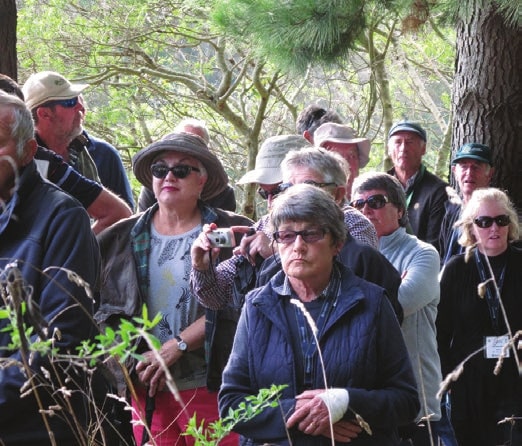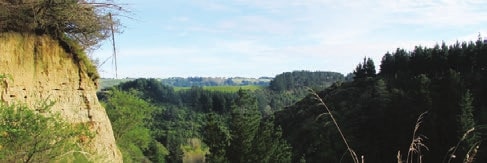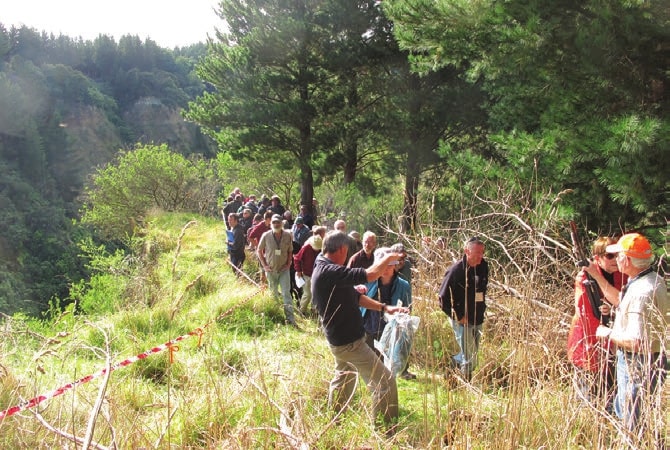Goulters Gully field day
Julian Bateson, New Zealand Tree Grower February 2018.
The 2017 conference hosted by Middle Districts had a range of good field days. The following pages have articles two more of these − the trip to Goulters Gully and on the logging demonstration day.
We decamped from the bus and were led carefully down a steep track, carefully avoiding the wasps’ nests which were clearly marked, although the wasps did not seem to keep within the boundaries. The track was on the edge of the deep gully system although it was so deep, were unable to see the bottom except in the distance. We ended up standing among some of the pine trees which had been left out of the recent harvest as they were very close to the edge of the gully.
The story was told how it all happened and how this deep gully appeared on relatively flat land. The river terrace was composed of very erodible sand, although superficially it had been very appealing flat terrace land. It had all been covered with native trees, as had most of New Zealand but by the early 1900s European settlers had removed the stabilising forest cover so that they could use it as farmland. This significantly modified the run-off. Some serious storms in the mid-1930s led to streams cutting through the protective loess soil and gravel cap resulting in very rapid gully erosion. Within 20 to 30 years a deep and unstable, canyon gully system 11 kilometres long covered almost 150 hectares. The banks were just bare sand and on windy days, the sand would swirl around in the wind.
Recovery plans
Remedial work started in 1958 with flood retention dams and flumes but in these were relatively ineffective even though farm boundaries, access and land ownership were badly affected. Then the Catchment Board and then the Regional Council took ownership of the gullies and effective plans were put into action.
Planting started in 1967 and by 1976 about 115,000 willow and poplar stakes had been planted. In addition, from 1972 to 1978 more than 70,000 radiata pine were also planted. This all worked well and the erosion was halted. However, as we all know, trees grow and by 2002 some of the pine trees were ready to harvest although they were of different ages with different silviculture − some pruned and some not.
Harvesting and replanting
The problem was then to find ways of harvesting which were not too expensive and did not result in allowing the land to erode again, although it was not as difficult as expected because the trees were on reasonable land. The harvesting took place in two parts, in 2002 and 2003. The first tender was won by John Turkingtons and with some partly pruned blocks, and some not, they did better than expected. The average harvest was 500 tonnes a hectare with a nett income of $13,000 a hectare which at the time seemed to be a good result.
The second tender produced a remarkable result and produced close to $32,000 a hectare. This was a lot more than expected and was because the successful tenderer was buying almost everything and outbidding all competition. But it was not all plain sailing as the contractor had overstretched and went bankrupt, fortunately just after the $868,000 income from the harvesting was paid. All this money went into future management of the erosion scheme. Replanting was then carried out and just before the serious floods of 2004. Joint venture projects in other places are being used to continue to help prevent erosion. The solutions at Goulters Gully have provided a lot of information for using afforestation to manage erosion.




 Farm Forestry New Zealand
Farm Forestry New Zealand